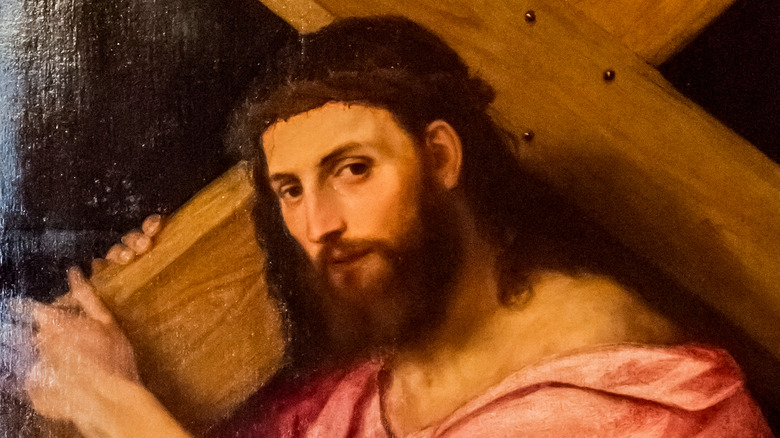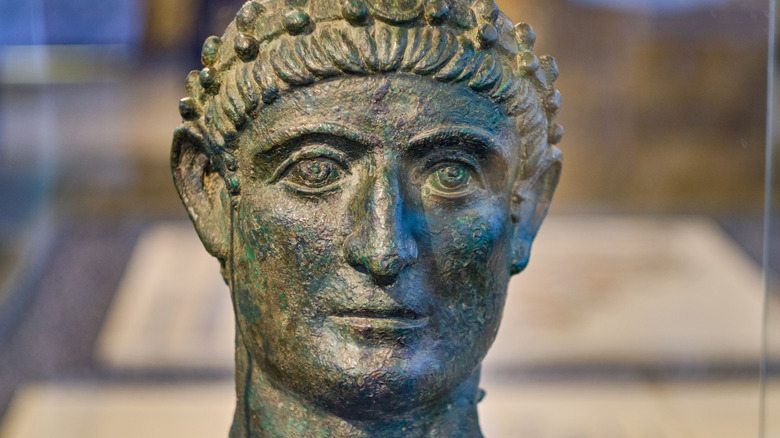Why Ancient Romans Used Crucifixion As Punishment
Imagine, for a moment, you were sentenced to death in Ancient Rome (tough break, no question). If you were lucky, your death might be swift — maybe you'd be beheaded, or thrown from a cliff like the Tarpeian Rock (via Atlas Obscura). But if you were convicted of a particularly heinous crime, especially if you were not a Roman citizen, you might be drowned in a river, buried alive, torn up by wild beasts, or, worst of all, crucified (per BBC and The Conversation).
Crucifixion was used as punishment for crimes that the Roman Empire considered dangerous. In particular, this meant political crimes against the state, which is how Romans likely interpreted the words of its most famous crucified prisoner, Jesus of Nazareth, who reportedly referred to himself as King of the Jews (via PBS). This is because crucifixion was an extremely visible and humiliating way to die.
"[This] sent a very powerful message to everybody else in those quarters that if you do or even think about doing what this guy's accused of having done, you, too, can wind up this way," said Harvard Divinity professor Allen D. Callahan to PBS, "and it was very effective; excruciating, perhaps the most excruciating form of capital punishment that we know."
The horrors of crucifixion: A long, painful, mortifying death
Before crucifixion, most prisoners were first scourged, for which they were stripped naked, tied to a post, and whipped bloody, according to Live Science. This part was often so brutal that some prisoners died before the actual crucifixion. Romans then forced prisoners to carry their own crosses to the site of their execution. At this point the prisoners were crucified, during which their hands or wrists and feet were either nailed or tied to the cross — either would eventually result in their death due to asphyxiation.
The condemned prisoners were crucified in public, while completely naked (via The Bart Ehrman Blog). While they waited on the cross to die — which could take up to four agonizing days — Roman guards could further torture them, perhaps in an attempt to get them to die faster, since the guards weren't allowed to leave their watch until the crucified prisoners had died, according to the National Library of Medicine.
The final humiliation and the end of (Roman) crucifixion
After the crucified prisoners finally perished — due to hemorrhage, dehydration, asphyxiation, or one of the numerous other side effects of their torture — their bodies were left on the cross to rot in the sun and be picked at by animals. Only days later would Romans take the bodies down from their crosses for disposal, throwing the corpses in a pit with other executed prisoners. In fact, Professor Bart Ehrman, the University of North Carolina professor and the author of "How Jesus Became God," believes this is ultimately what happened to Jesus' body, rather than the entombment described in the Bible.
The Roman Empire did eventually outlaw crucifixion almost 300 years after Jesus' death. Emperor Constantine the Great (above) abolished the practice after his conversion to Christianity (via Britannica). Crucifixion didn't end there, however. In the 16th and 17th centuries, the torturous method of capital punishment was used in Japan, and it persisted in that culture to the point where there are several instances of Japanese soldiers crucifying enemy combatants during World War II (per the BBC). And in Saudi Arabia, a version of crucifixion — in which, after a condemned person is beheaded, their body is hung and displayed — exists today.


